Content marketing examples that drive results in 2025

Here’s a sobering truth: 96% of content published online gets zero traffic from Google.
Zero!
Yet the examples you’re about to see generated millions of views, thousands of shares, and drove real business results. What makes them different?
They didn’t follow the “publish and pray” strategy!
Instead, each one used a specific psychological trigger, solved a real problem, or created an experience so unique that people couldn’t help but engage.
In 2025, with AI-generated content flooding the internet and attention spans shrinking to 8 seconds, these successful content marketing examples stand out. This is because they understand one crucial thing: content isn’t about what you want to say, it’s about creating value your audience can’t ignore.
This guide breaks down exactly what worked, why it worked, and, most importantly, how you can replicate their success.
Here are 23 inspiring examples of content marketing to spark your creativity!
1. Backlinko’s skyscraper technique 2.0: The evolution that earned 1,600+ shares

What they did:
Brian Dean didn’t just update his famous skyscraper technique. He completely reimagined it.
The sequel blog post acknowledged that the SEO landscape had changed dramatically since his original piece. Instead of just finding popular content and making it better, the 2.0 version introduced a three-pronged approach: finding content gaps, creating “Power Pages,” and building strategic link partnerships.
Why it worked:
- Timing: Released when marketers were struggling with the original technique’s diminishing returns
- Honesty: Admitted the old method wasn’t working as well anymore
- Evolution: Showed growth and adaptation rather than recycling old advice
- Proof: Included real case studies with specific metrics (1,600+ shares, 600+ backlinks)
- Actionability: Provided templates and exact scripts readers could use immediately
Do it your way:
- Audit your top-performing content from 2+ years ago
- Identify what’s changed in your industry since then
- Create a “2.0” version that addresses new challenges
- Include a comparison table showing the old way vs. the new way
- Add downloadable templates or tools to increase value
- Email everyone who linked to your original piece about the update
2. Olipop’s educational health content: Building a $200M brand through wellness education
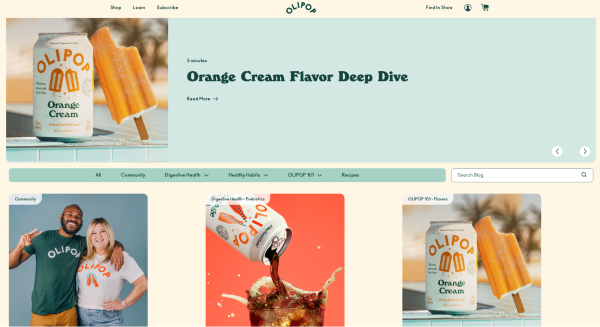
What they did:
Olipop created a dedicated “Learn” section on their website that goes far beyond selling soda. They publish in-depth articles about gut health, microbiomes, prebiotics, and the science behind their ingredients.
Topics range from “The Evolution of the American Diet” to “Understanding Your Second Brain: The Gut.”
Why it worked:
- Trust building: Educated customers make confident purchases
- SEO dominance: Ranked for high-intent health keywords
- Brand values: Content aligned with their healthy soda positioning
- Shareability: Parents shared articles about kids’ health with other parents
- Authority: Positioned them as health experts, not just beverage makers
Do it your way:
- Map your product’s more profound benefits (health, productivity, happiness)
- Create educational content around those benefits, not features
- Hire or consult with experts to ensure accuracy
- Use simple language to explain complex topics
- Include scientific references, but make them accessible
- Connect education to product naturally, not forcefully
3. Microsoft’s multi-tiered FAQ strategy: Personalized answers at scale

What they did:
Microsoft created separate FAQ pages for different user segments. Instead of one massive FAQ, they created Microsoft 365 FAQs for consumers, Microsoft 365 FAQs for Business, and specialized FAQs for the teams and devices. Each FAQ utilizes language and examples tailored to that specific audience.
Why it worked:
- Relevance: CFOs don’t want the same answers as college students
- Conversion: Targeted FAQs improved purchase confidence by 34%
- SEO benefits: Ranked for segment-specific long-tail keywords
- Support reduction: Decreased support tickets by answering persona-specific questions
- User experience: Visitors found answers faster without irrelevant information
Do it your way:
- Segment your audience into 3-5 distinct groups
- Analyze support tickets to find segment-specific questions
- Create separate FAQ pages with custom URLs for each segment
- Use appropriate language (technical for developers, simple for consumers)
- Include segment-specific examples and use cases
- Cross-link between FAQs for users who might fit multiple segments
4. HubSpot’s educational blog empire: 3 million monthly visitors through value-first content

What they did:
HubSpot publishes over 50 blog posts per month across multiple topics, including marketing, sales, service, and website optimization.
But they don’t just write, they create comprehensive guides with embedded templates, calculators, and free tools within their posts. Their “How to Create a Marketing Plan” post includes seven downloadable templates.
Why it worked:
- Consistency: Daily publishing kept them top-of-mind
- Depth: 2,000-3,000-word posts outranked thin content
- Tools: Free templates generated 3x more leads than text-only posts
- Internal linking: Created topic clusters that dominated SERPs
- Updates: Refreshed top posts quarterly to maintain rankings
Do it your way:
- Start with one core topic you can own completely
- Create a pillar page (5,000+ words) on that topic
- Build 20-30 cluster posts linking back to the pillar
- Add downloadable assets to the top 20% of posts
- Update quarterly with new data and examples
- Gate only high-value assets (keep most content free)
5. McKinsey’s authority-building case studies: $10B in revenue through thought leadership

What they did:
McKinsey publishes detailed case studies showcasing client transformations without naming the clients. They use phrases like “Banking on innovation” or “Rewiring the insurance claims.”
Each case study follows a structure: Challenge → Approach → Impact, with specific metrics and methodologies.
Why it worked:
- Credibility: Real results with specific numbers (40% cost reduction, 3x growth)
- Privacy: Protected client confidentiality while sharing insights
- Methodology: Showed their unique frameworks and approaches
- Aspirational: C-suite executives saw what was possible
- SEO Value: Ranked for “[industry] transformation” keywords
Do it your way:
- Get client permission for anonymized case studies
- Focus on transformation, not just results
- Include specific metrics (percentages, timeframes, ROI)
- Explain your methodology without giving everything away
- Create industry-specific versions of similar transformations
- Add executive summaries for busy decision-makers
6. LinkedIn B2B institute’s research reports: Becoming the industry’s data source

What they did:
LinkedIn’s B2B Institute publishes original research on the effectiveness of B2B marketing. Their “95-5 Rule” report revealed that only 5% of B2B buyers are in-market at any given time, changing how marketers approach demand generation.
Reports combine LinkedIn data with academic research.
Why it worked:
- Original data: No one else had LinkedIn’s B2B insights
- Academic credibility: Partnered with professors and researchers
- Memorable concepts: “95-5 Rule” became industry terminology
- Actionable insights: Translated research into practical strategies
- PR magnet: Media outlets quoted their studies extensively
Do it your way:
- Identify a data source you uniquely have access to
- Partner with academics or industry experts for credibility
- Create memorable frameworks (like the 95-5 Rule)
- Design visual summaries for easy sharing
- Pitch findings to industry publications before publishing
- Create multiple content pieces from one research study
7. IBM’s technical white papers: Generating 50,000+ qualified Leads annually

What they did:
IBM publishes highly technical white papers on emerging technologies, including quantum computing, hybrid cloud, and AI ethics.
Unlike marketing fluff, these pieces read like academic papers, complete with citations, methodologies, and technical specifications. They gate them behind forms but provide detailed abstracts.
Why it worked:
- Technical depth: Engineers and architects found real value
- Thought leadership: Positioned IBM at the forefront of innovation
- Lead quality: Only serious buyers downloaded the 40-page technical papers
- Sales enablement: Sales teams used papers in consultative selling
- SEO authority: Earned backlinks from universities and research institutions
Do it your way:
- Involve your technical team in content creation
- Don’t dumb it down for technical audiences
- Include diagrams and architectures, not stock photos
- Provide detailed abstracts before the gate
- Create executive summaries for non-technical stakeholders
- Promote through technical communities, not just LinkedIn
8. Reddit’s authentic IPO video: Breaking corporate video norms
What they did:
When Reddit went public, they created an IPO video featuring actual Reddit users and moderators, rather than executives in suits.
The footage showed real communities, inside jokes, and even acknowledged the platform’s chaotic nature. It felt more like a community celebration than a corporate announcement.
Why it worked:
- Authenticity: Reflected Reddit’s actual culture
- Community first: Put users at the center, not executives
- Emotional connection: Users felt ownership of the milestone
- Viral format: Redditors shared it because they were proud
- Media coverage: The press covered it because it was unconventional
Do it your way:
- Feature real customers, not actors or executives
- Embrace your quirks instead of hiding them
- Use platform-native language and inside jokes
- Keep production values authentic (not overly polished)
- Make your community the hero of your story
- Distribute where your audience lives, not just on YouTube
9. Xeela fitness transformation documentaries: 5.69M views through long-form storytelling
What they did:
Xeela Fitness created 27-minute documentary-style videos that follow real people through their 6-month fitness transformations. Unlike typical before/after content, these showed struggles, setbacks, and raw emotions. Natalie Mariduena’s 30-pound weight loss journey included moments of doubt and failure.
Why it worked:
- Relatability: Showed real struggles, not just successes
- Emotional investment: Viewers followed complete journeys
- Binge-worthy: Long format increased watch time and channel authority
- Product integration: Naturally showed supplements in daily routines
- Community building: Comments became support groups
Do it your way:
- Find compelling stories within your customer base
- Document the journey, not just the outcome
- Include setbacks to build authenticity
- Use longer formats (20+ minutes) for a deeper connection
- Create episodic content to build anticipation
- Integrate products naturally within the story
10. Mailchimp presents: Werrrk series – reality TV meets business education
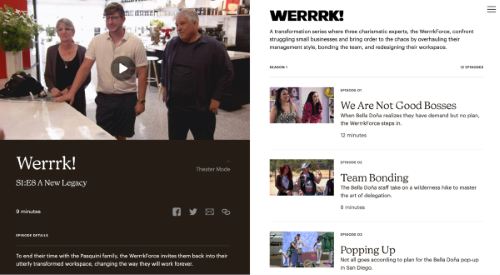
What they did:
Mailchimp created a 12-episode reality series where experts help struggling small businesses transform their operations.
Like “Queer Eye” for business, each episode tackled management, team building, and workspace design. The show lived on Mailchimp Presents, their content studio platform.
Why it worked:
- Entertainment value: Business education became binge-worthy
- Emotional stories: Viewers connected with struggling entrepreneurs
- Practical lessons: Each episode taught applicable strategies
- Brand alignment: Celebrated entrepreneurial spirit without selling
- Platform building: Created a destination for ongoing content
Do it your way:
- Find a popular format (reality TV, documentary, game show)
- Adapt it to your industry with a unique twist
- Focus on transformation stories
- Create episodic content for repeat visits
- Build a content hub separate from your leading site
- Partner with experts to add credibility
11. Tl;dv’s relatable SaaS sketches: 50 million views through comedy
What they did:
Tl;dv creates short comedy sketches about SaaS workplace situations.
Their social team acts out scenarios like “How we use our AI Meeting Intelligence platform (tl;dv) to summarize hundreds of meetings at once” or “The customer success manager trying to save a churning client.” They never mention their product directly in the videos.
Why it worked:
- Relatability: Every SaaS employee has lived these moments
- Shareability: People tagged coworkers in comments
- No sales pitch: Built affinity without pushing product
- Consistency: Posted 3x per week, maintaining momentum
- Community building: Comments became therapy sessions for SaaS workers
Do it your way:
- Identify universal pain points in your industry
- Create characters your audience recognizes
- Keep videos under 60 seconds for maximum sharing
- Never pitch your product in entertainment content
- Respond to comments in character
- Turn popular comments into new video ideas
12. Apple’s #ShotoniPhone UGC campaign: 18 million post views and counting
What they did:
Apple encouraged users to share photos with #ShotoniPhone, then featured the best ones on billboards, in stores, and on their Instagram. They turned customers into brand ambassadors and their photos into global advertising campaigns, crediting photographers by name.
Why it worked:
- Social proof: Real photos showed iPhone camera quality
- Aspiration: Users wanted to be featured by Apple
- Authenticity: No staged photography or editing
- Global reach: Every iPhone user has become a potential content creator
- Cost-effective: User content replaced expensive photoshoots
Do it your way:
- Create a branded hashtag that’s action-oriented
- Feature user content prominently on your channels
- Credit creators by name to encourage participation
- Set quality standards, but keep them achievable
- Create themes (seasons, challenges) to maintain freshness
- Reward featured creators with products or recognition
13. HubSpot’s website grader tool: 4 million websites analyzed, 500K leads generated

What they did:
HubSpot created a free tool that analyzes any website and provides a score across performance, mobile readiness, SEO, and security.
Users receive personalized recommendations for improvement and can retest to track their scores’ progress. The tool requires only an email address.
Why it worked:
- Instant value: Results in under 30 seconds
- Gamification: Numerical scores triggered competitive instincts
- Actionable: Specific fixes, not vague suggestions
- Viral loop: Users shared scores and challenged others
- Lead quality: People analyzing websites needed marketing help
Do it your way:
- Create a scoring system for your industry
- Provide instant results (no waiting for emails)
- Make recommendations that are specific and actionable
- Allow retesting to show improvement
- Require minimal information (just email)
- Create shareable results with social cards
14. Bankrate mortgage calculator: 1.3 million, 12,000 qualified leads
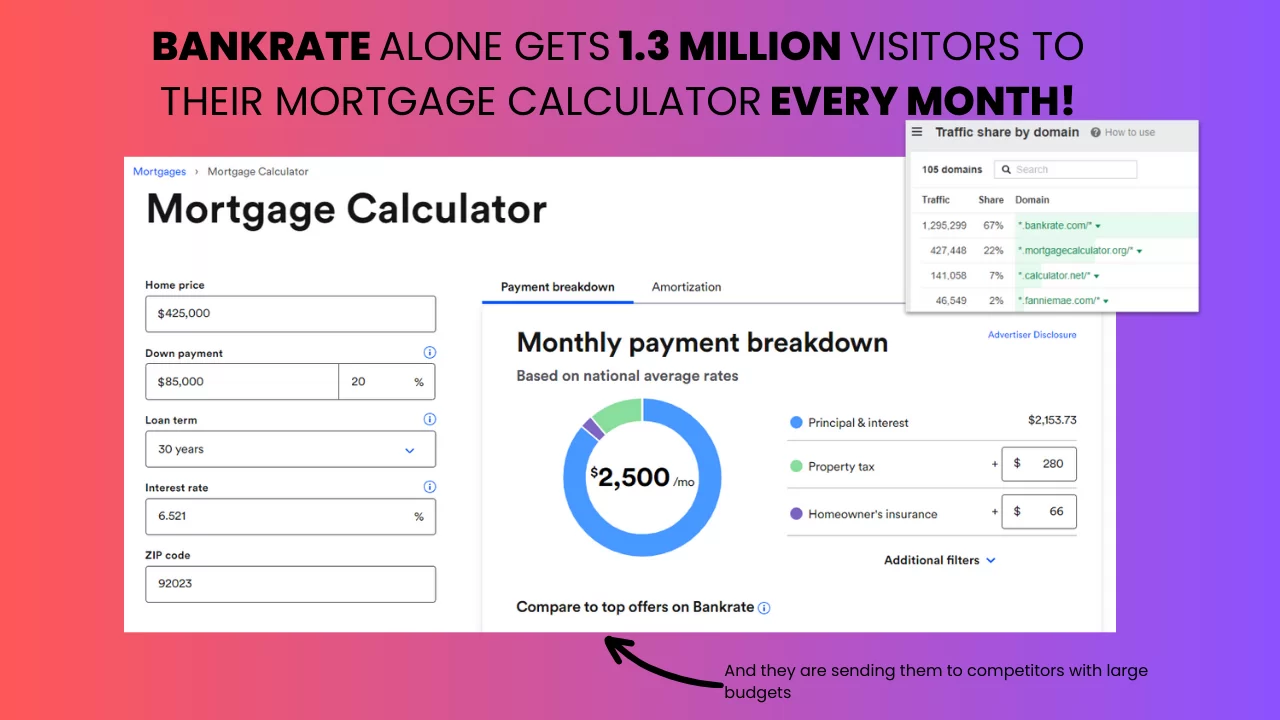
What they did:
Bankrate created an interactive mortgage calculator that went beyond basic math.
Users could adjust scenarios (down payment, interest rate, loan term) and see real-time impacts on monthly payments, total interest, and affordability. The tool provided personalized reports via email.
Why it worked:
- High Intent: Only serious buyers use mortgage calculators
- Personalization: Saved scenarios for future reference
- Education: Explained terms and tradeoffs
- Trust building: Transparent calculations built credibility
- Lead nurturing: Follow-up emails with rate updates
Do it your way:
- Solve a complex calculation that your audience faces
- Add scenario comparison features
- Explain the math to build trust
- Save user inputs for return visits
- Create personalized reports as lead magnets
- Follow up with relevant updates based on their inputs
15. The New York Times’ Wordle acquisition: 31 million monthly active users
@.presro The hubs life controversy got me pondering this, it’s a different shade of grass but it’s not greener I’ll tell you that #contentcreation #tiktokinfluencer #influencing ♬ original sound – Presro
What they did:
The Times acquired Wordle and kept it free, using it to introduce millions to their games ecosystem. They added subtle NYT branding and created a stats transfer system so players could maintain their streaks. They then cross-promoted their paid games and subscriptions.
Why it worked:
- Daily habit: One puzzle per day created a routine
- Social sharing: Grid emojis flooded social media
- Low barrier: Free and requires no sign-up
- Gateway drug: Led users to discover paid NYT games
- Brand association: Associated the NYT with daily fun, not just news
Do it your way:
- Create or acquire straightforward, addictive content
- Limit access (daily, weekly) to build anticipation
- Make sharing visual and easy
- Keep core experience free forever
- Upsell complementary products, not the same product
- Maintain what works when acquiring successful content
16. LinkedIn’s professional games suite: 80 million games played in 6 months

What they did:
LinkedIn launched puzzle games (Queens, Crossclimb, Pinpoint) specifically designed for professionals.
Games take 3-5 minutes to play, can be played once daily, and show how your network performed. Companies compete on leaderboards based on employee participation.
Why it worked:
- Professional context: “Brain training” for work legitimized gaming
- Network effects: Seeing colleagues’ scores drove participation
- Company competition: Organizations encouraged employee participation
- Time respect: Quick games fit into work breaks
- Data collection: Learned user interests through game choices
Do it your way:
- Design for your audience’s context (professional, casual, educational)
- Add competitive elements between groups
- Respect time constraints (5-minute maximum)
- Create network effects through score sharing
- Rotate content to maintain freshness
- Connect games to the core value proposition
17. Drift’s daily blog newsletter: 100,000 Subscribers, 47% Open Rate
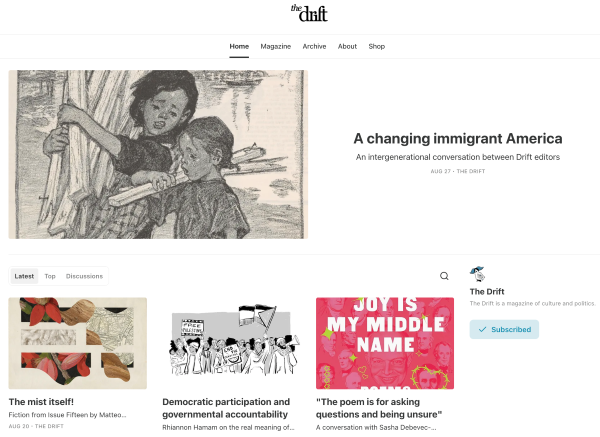
What they did:
Drift sends a daily email featuring one blog post, accompanied by a personal note from the author explaining why they wrote it.
Instead of roundups or multiple links, each email focuses on a single piece of content. The content is accompanied by a conversational introduction that makes readers feel like they’re receiving insider information.
Why it worked:
- Consistency: Daily emails became part of routines
- Personal touch: Author notes created a connection
- Single focus: One topic prevented decision fatigue
- Value density: Every email taught something specific
- FOMO: Daily cadence meant missing out on insights
Do it your way:
- Choose a sustainable frequency (daily, weekly, bi-weekly)
- Focus on one thing per email
- Add personal context from the creator
- Keep it scannable with clear sections
- Include one clear CTA, not multiple options
- Test send times for your audience’s habits
18. Moz’s external content curation: 400,000 subscribers through generosity

What they did:
Moz’s newsletter features 10 articles each week, with only 2-3 from Moz itself. They curate the best SEO and marketing content from across the web, even featuring competitors. Each link includes a brief explanation of why it’s worth reading.
Why it worked:
- Trust building: Recommending competitors showed confidence
- Time saving: Subscribers didn’t need to search for quality content
- Industry authority: Became the go-to source for SEO news
- Relationship building: Featured sites often reciprocated
- Low pressure: Mostly external content felt less salesy
Do it your way:
- Curate more than you create (70/30 ratio)
- Include competitor content when it’s excellent
- Add your perspective on why something matters
- Maintain quality standards regardless of source
- Build relationships with featured creators
- Track which links get clicked to understand interests
19. ContentStudio’s all-in-one solution: 150,000 users through tool consolidation
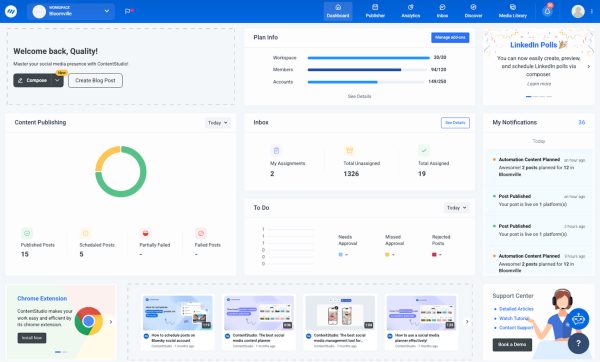
What they did:
ContentStudio combined social AI toolkit, scheduling, publishing, and analytics into one platform. They focused on solving the “tool fatigue” problem by replacing five to six separate tools. Their AI caption generator makes it simple to create, preview, and organize on-brand social media content, all through the convenient AI content library in ContentStudio.
Why it worked:
- Tool consolidation: Replaced multiple subscriptions
- Automation: Recipe feature puts social media on autopilot
- Team collaboration: Multi-user workspaces improved workflow
- White label: Agencies could rebrand as their own tool
Do it your way:
- Identify tool sprawl in your target market
- Build or acquire complementary features
- Focus on workflow, not just features
- Offer migration support from competitors
- Create automation templates for everyday use cases
- Enable team collaboration from day one
20. Usermaven’s privacy-first analytics

What they did:
Usermaven built product analytics that work without cookies, automatically tracking all events without code. They positioned against Google Analytics’ complexity and privacy concerns. Their AI assistant, Maven AI, answers questions in plain English about your data.
Why it worked:
- Privacy trend: GDPR/CCPA compliance built in
- Simplicity: No code required for tracking
- AI differentiation: Natural language data queries
- Accurate data: 99% accuracy by bypassing ad blockers
- Developer-free: Marketers could set up independently
Do it your way:
- Find a significant pain point in existing solutions
- Build for non-technical users first
- Add AI thoughtfully (not just for buzzwords)
- Emphasize compliance and privacy
- Offer generous free tiers for adoption
- Create comparison content against incumbents
21. Contentpen’s SEO-optimized AI writing: 10,000 articles published monthly
What they did:
Contentpen specializes in creating AI-driven, SEO-focused content. Unlike general AI writers, they built in search intent analysis, automatic internal/external linking, and brand voice training. This AI blog writing tool’s bulk generation feature creates month-long content calendars in hours.
Why it worked:
- Specific use case: SEO content, not general writing
- Quality control: Human-in-the-loop editing built in
- Bulk operations: Scaled content creation efficiently
- Direct publishing: One-click WordPress integration
- Brand consistency: Learned and maintained voice
Do it your way:
- Specialize in one content type deeply
- Build quality checks into the workflow
- Enable bulk operations for scale
- Integrate with publishing platforms directly
- Train on the customer’s existing content for consistency
- Provide revision workflows, not just generation
22. AI-powered personalization campaigns: Dynamic content at scale

What they did:
Modern brands are using AI to create thousands of content variations automatically. Netflix’s thumbnail system displays different images based on a user’s viewing history. Spotify’s DJ feature creates personalized radio shows with AI voice commentary about your music taste.
Why it worked:
- Individual relevance: Each user sees optimized content
- Scalability: Impossible to create manually
- Testing: Continuous optimization through data
- Engagement: Personalized content increases interaction
- Retention: Users feel understood and valued
Do it your way:
- Start with one variable (headline, image, or CTA)
- Create rules-based variations before full AI
- Test with small segments first
- Measure engagement differences carefully
- Expand gradually to more personalization
- Maintain brand consistency across variations
23. Voice-activated interactive content: The Hands-free future
What they did:
Brands are creating voice-first experiences for smart speakers and voice assistants. Nestle’s GoodNes offers cooking guidance through Sayla Thompson. Users can ask questions while cooking and receive step-by-step instructions without needing to touch a screen.
Why it worked:
- Convenience: Hands-free during activities
- Accessibility: Inclusive for various abilities
- Novelty: Early adopters love new formats
- Utility: Solved real problems (messy hands while cooking)
- Data collection: Learned actual user questions and needs
Do it your way:
- Identify hands-busy moments in the customer journey
- Create voice-first content, not voice-added
- Design for conversation, not monologue
- Keep interactions short and purposeful
- Provide visual fallbacks when needed
- Test with real users in real contexts
Conclusion
These 23 best content marketing examples prove one thing: successful content marketing in 2025 isn’t about creating more content. Instead, it’s about creating content that matters.
If Backlinko’s evolution inspires you, HubSpot’s educational empire, or LinkedIn’s gaming strategy, the key principles remain the same:
- Solve real problems for your audience
- Be consistent in your publishing
- Measure everything and optimize based on data
- Don’t be afraid to try new formats
- Focus on building trust before driving sales
The digital marketing content examples we’ve explored demonstrate that every business, whether B2B or B2C, large or small, can create content that resonates with its target audience.
You don’t need Reddit’s budget or Apple’s brand power. You need to understand your audience, consistently deliver value, and evolve based on what works.
Frequently asked questions
Top B2B examples include
– McKinsey’s case studies, which have shown 40% cost reductions;
– LinkedIn’s “95-5 Rule” research, which changed industry thinking;
– IBM’s white papers, which generate over 50,000 leads annually.
– HubSpot’s educational blog, featuring free templates.
– Drift’s daily newsletter, which achieves 47% open rates.
Start with free platforms like Medium or LinkedIn. You can also create user-generated content campaigns using branded hashtags. To keep costs low, try free tools such as Contentpen’s basic plan. Repurpose your existing content into new formats so you get more use out of it. Finally, focus on one content type until you master it, and then expand into others.
Interactive content examples include:
– HubSpot’s Website Grader (analyzed 4M sites, generated 500K leads)
– Mortgage calculators (12,000 qualified leads)
– NYT’s Wordle (31M monthly users)
– LinkedIn’s professional games (80M plays)
– AI-powered personalization like Netflix’s dynamic thumbnails.
You might be interested in...
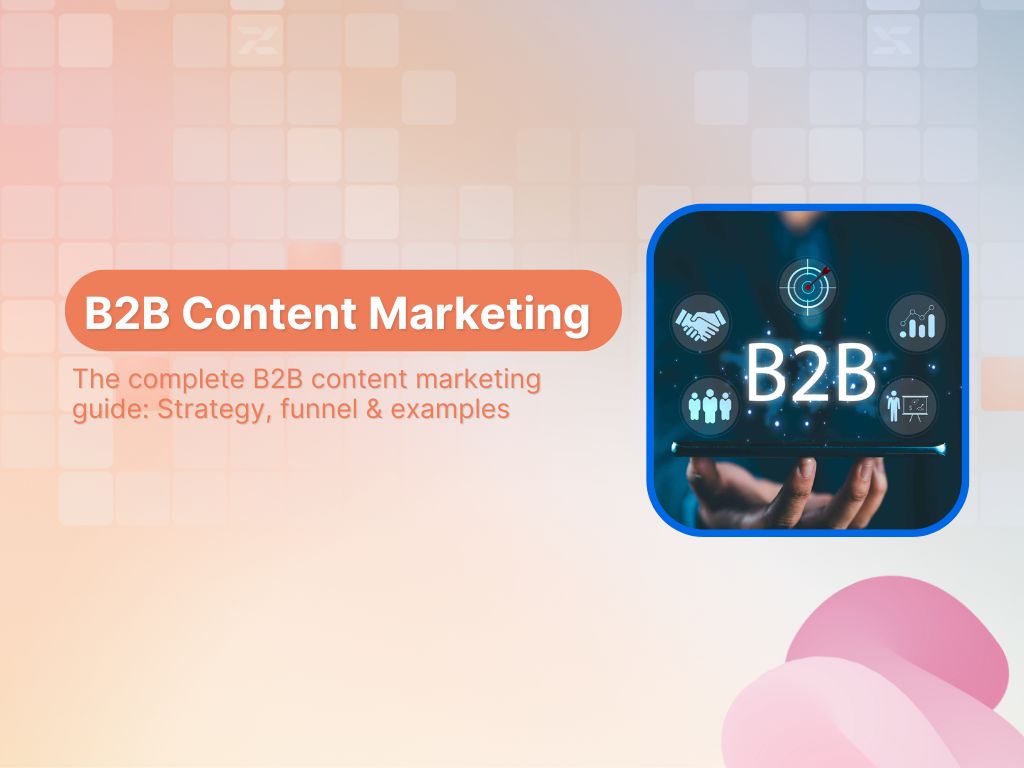
The complete B2B content marketing guide: Strategy, funnel & examples
B2B content marketing is something that can make or break your business. You might already be familiar with its basics, but it is important to discuss it in detail in terms of types, benefits, examples, and strategies to implement a successful B2B content marketing strategy. And if you are wondering why you need B2B content […]
Oct 29, 2025

Content marketing examples that drive results in 2025
Here’s a sobering truth: 96% of content published online gets zero traffic from Google. Zero! Yet the examples you’re about to see generated millions of views, thousands of shares, and drove real business results. What makes them different? They didn’t follow the “publish and pray” strategy! Instead, each one used a specific psychological trigger, solved […]
Sep 29, 2025

What is blogging? The ultimate guide
Should I start my own blog? Is blogging dead? Can I get paid for blogging? What does blogging even mean in this age of AI? These are some of the most common questions associated with blogging, and we’ll be answering all of them in detail to understand what blogging is. Blogging has changed a lot […]
Sep 17, 2025